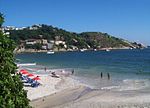Guaratiba
Beaches of Rio de Janeiro (city)Neighbourhoods in Rio de Janeiro (city)Rio de Janeiro (state) geography stubs

Guaratiba is a large neighborhood in the West Zone of Rio de Janeiro, Brazil, on the east side of Sepetiba Bay. Its population density is among the lowest in the city. It contains the 3,360 hectares (8,300 acres) Guaratiba Biological Reserve, a strictly protected conservation unit holding a remnant of mangroves. The region expanded in 2008 due to real estate investment, anticipating easier access via the Grota Funda tunnel (pt) which was scheduled to be finished that year.
Excerpt from the Wikipedia article Guaratiba (License: CC BY-SA 3.0, Authors, Images).Guaratiba
Caminho das Estrelas, Rio de Janeiro Barra de Guaratiba
Geographical coordinates (GPS) Address Nearby Places Show on map
Geographical coordinates (GPS)
| Latitude | Longitude |
|---|---|
| N -23.068055555556 ° | E -43.561666666667 ° |
Address
Caminho das Estrelas
Caminho das Estrelas
23020-340 Rio de Janeiro, Barra de Guaratiba
Rio de Janeiro, Brazil
Open on Google Maps






